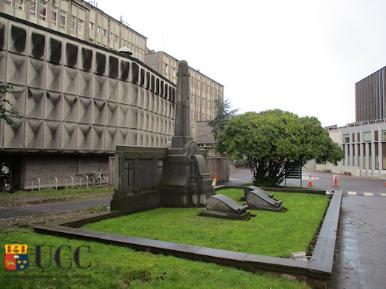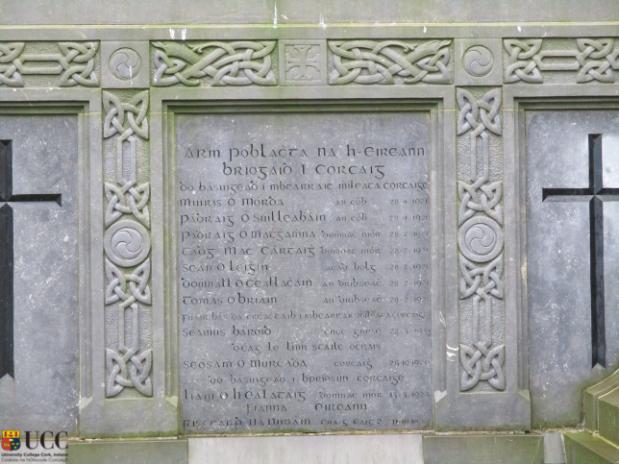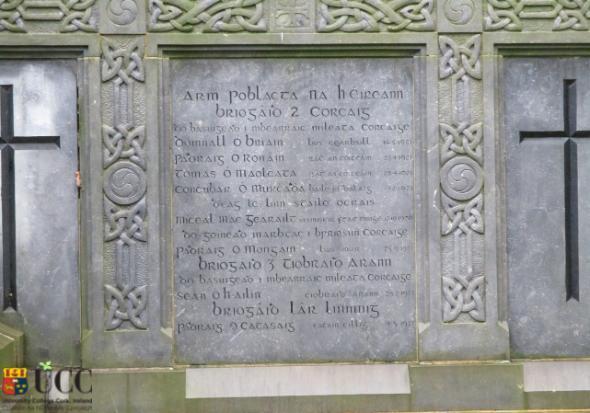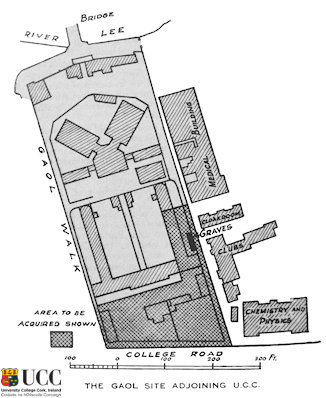The Republican Grave

The University College Cork campus includes a mass grave of thirteen Irish Republican Army (Old IRA) members executed by the British government in 1921. They were shot by British Army firing squads at the Cork Detention Barracks inside Victoria Barracks (now Collins Barracks) at different dates in 1921, and buried on the grounds of Cork Men’s Gaol, the site of which was later taken over by UCC.
Following an escalation of the War of Independence, the British government introduced martial law to the rebellious province of Munster in December 1920 (it was extended to counties Kilkenny and Wexford subsequently). Among its many provisions was the death penalty for any civilian caught in possession of arms, ammunition, or explosive. The thirteen IRA Volunteers buried at UCC were all sentenced to death for this infraction.
The first prisoner executed was IRA Captain Cornelius Murphy (aged 30), of the Rathduane Company, Millstreet Battalion, Cork No. 2 Brigade. He was shot by British firing squad on 1 February 1921. On 28 February six IRA Volunteers were executed, five of whom had been captured in an abortive ambush at Dripsey by the 6th Battalion, Cork No. 1 Brigade. They were Volunteers Patrick O’Mahony Jr (aged 30) of Berrings, Inishcarra; Timothy McCarthy (aged 21), Fornaught, Donoughmore; John Lyons (aged 27), Aghabulloge; Thomas O’Brien (aged 20), Model Village, Dripsey; and Daniel O’Callaghan (aged 22), Dripsey. Also executed that day was Captain Seán Allen (aged 27) of Tipperary town, 4th Battalion, Tipperary No. 3 Brigade.
The next round of executions occurred during a four day span in April and May 1921. On 28 April, Volunteer Maurice Moore (aged 26) of Cobh, County Cork and Lieutenant Patrick Sullivan (aged 24) also of Cobh, were both shot, following their capture during the Fourth Battalion, Cork No. 1 Brigade flying column disaster at Clonmult. On the same day, Volunteers Thomas Mulcahy (aged 25) and Patrick Ronayne (aged 26), both of Burnfort, Mallow, County Cork, died by firing squad. Members of the 5th Battalion, Cork No. 2 Brigade, they were captured at the miscarried Mourne Abbey Ambush. Four days later, on 2 May, a firing squad shot Volunteer Patrick Casey (aged 26) of Caherly, Grange, County Limerick. He was the quartermaster of the 5th Battalion, Mid-Limerick Brigade, captured after a firefight at Knockanevin. The final execution occurred on 16 May 1921. Volunteer Daniel O’Brien (aged 30) of Knockardbane (County Cork) was shot five days after his capture Aughrim, following service with the Liscarroll Company, Charleville Battalion of the Cork No. 2 Brigade.
The monument
In 1944 the Cork Gaol Memorial Committee of the Old IRA Men’s Association, under the chairmanship of Tom Crofts, began collecting funds for a suitable memorial. By the summer of 1946, £2,000 had been collected. The Cork sculptor, Séamus Murphy RHA, was commissioned to create the stone plaque on the front wall of the gaol. The plaque, which is dated 1947, is of limestone in three panels, all framed in bronze. The names of eighteen men are finely etched in Gaelic lettering. These included seventeen men who had lost their lives on the gaol grounds during the 1920-23 period were remembered: 13 executed in 1921, one executed during the Irish Civil War (William Healy, 13 March 1923), two who died on hunger strike (Michael Fitzgerald, 17 October 1920, and Joseph Murphy, 25 October 1920), one executed during the Irish Civil War (William Healy, 13 March 1923), and one was shot by a Free State sentry during a prison disturbance (Patrick Mangan, 25 September 1922); and the final name was that of Captain James Barrett of Firmount, County Cork, who had been wounded during the Dripsey Ambush and died in the military hospital at Victorian Barracks on 22 March 1921.
The monument over the grave was created by John A. O'Connell and Sons – the name 'O Conaill’ is inscribed on the back panel of the monument – O'Connells had their stone yard at Watercourse Road. This monument takes the form of a two vertical back panels, on which the names are carved, on either side of an stylised cross, designed by Somhairle Mac Cana ARCA (principal of the Cork Municipal School of Art).
There are thirteen burials in the plot (and these names are on the gaol wall memorial also), but a fourteenth name (Risteard Ua Nunáin / Richard Noonan, of Fianna Éireann, has been added to the left-hand panel on the grave monument although he is buried elsewhere. The three stones on the grass at the front of the monument repeat the names in English of those buried in this plot, with place of origin, along with a text:
'Here lie the mortal remains of 13 Volunteers of the Irish Republican Army executed by British firing squads in the Cork Military Barracks in 1921 and buried here in what was then a part of the exercise yard of the former Cork County Jail.'
In the centre, under the army badge on oak and laurel leaves, the quotation from Padraic Pearse is repeated (in a different transliteration):
“Beidh iomrádh ortha i measc a muinntire cuimhneochaidh an uile ghlún iad agus mórfaid said a n-ainm
Pádraig Mac Piarais”
The names, in Irish, are repeated again, carved in the coping stones at the front.
There are two inscribed panels on either side of the cross.
List of names on the left-hand panel
Eleven names are listed on the left-hand panel.

Transcription:
Arm poblachta na h-Éireann briogaidh i Corcaigh
Do básuigheadh i mBearraic Mhileata Chorcaighe
| Muiris Ó Mórdha |
An Cóbh |
28-4-1921 |
| Pádraig Ó Súilleabháin |
An Cóbh |
28-4-1921 |
| Pádraig Ó Mathghamhna |
Domhnach Mór |
28-2-1921 |
| Tadhg Mac Cárthaigh |
Domhnach Mór |
28-2-1921 |
| Seán Ó Leighin |
Achadh Bolg |
28-2-1921 |
| Domhnall Ó Ceallacháin |
An Dribseach |
28-2-1921 |
| Tomás Ó Briain |
An Dribseach |
28-2-1921 |
Fuair bás dá chréachtaibh i mBearraic Mhileata Chorcaighe
| Séamus Bároid |
Cnoc Giúise |
22-3-1921 |
James Barrett (Séamus Bároid), who died in the hospital at Victoria Barracks, Cork, is buried in the Republican plot, Donoughmore Cemetery, Co. Cork.
D’éag le linn stailc ocrais
| Seósamh Ó Murchadha |
Corcaigh |
25-10-1920 |
Joseph Murphy (Seósamh Ó Murchadha), who died on hunger strike at Cork Gaol, is buried in the Republican plot, St Finbarr’s Cemetery, Cork.
Do básuigheadh i bPríosún Chorcaighe
| Liam Ó hÉalathaigh |
Domhnach Mór |
13-3-1923 |
Liam Healy (Liam Ó hÉalathaigh), who was executed in Cork Prison, is buried in the Republican plot, Donoughmore Cemetery, Co. Cork.
Fianna Éireann
| Risteárd Ua Núnáin |
Cua g Caith 2 |
11-10-1922 |
Richard Noonan (Risteárd Ua Núnáin), who died in the Cork Men's Gaol, is buried in the Republican plot, St Finbarr’s Cemetery, Cork.
Names on the right-hand panel
Eight names are listed on the right-hand panel.

Transcription:
Arm Poblachta na h Éireann
Briogaid 2 Corcaigh
Do básuigheadh i mBearraic Mhileata Chorcaighe
| Domnall Ó Briain |
Lios Cearbhaill |
16-5-1921 |
| Pádraig Ó Ronáin |
Ráth an Tóiteáin |
28-4-1921 |
| Tomás Ó Maolchatha |
Ráth an Tóiteáin |
28-4-1921 |
| Conchubhar Ó Murchú |
Baile Uí Dhálaigh |
1-2-1921 |
D’éag le linn stailc ocrais
| Mícheál Mac Gearailt |
Mainistir Fhear Muighe |
17-10-1920 |
Do goineadh marbhtach i bPriosún Chorcaighe
| Pádraig Ó Mongáin |
Lios Mór |
25-9-1920 |
Briogáid 3 Tiobraid Árann
Do básuigheadh i mBearraic Mhileata Chorcaighe
| Seán Ó h-Ailín |
Tiobraid Árann |
28-2-1921 |
Briogáid Lár Luimnigh
| Pádraig Ó Cathasaigh |
Cathair Cilligh |
4-5-1921 |
The 'scrolls' and coping stones
The 'scrolls'
There are three limestone 'scrolls' placed in front of the grave plot monument. These were part of the refurbishment of the site in 1992. The two placed, on left and right, list the names of the thirteen men who are buried here. The centre stone is inscribed:
"Here lies the mortal remains of 13 volunteers of the Irish Republic Army executed by British firing squads in the Cork Military Barracks in 1921 and buried here in what was then a part of the exercise yard of the former Cork County Jail"
The English translation is below the corresponding Irish text:
| Left scroll – 7 names: |
|
Right scroll – 6 names: |
|
| Maurice Moore |
Dripsey |
Daniel O’Brien |
Liscarroll |
| Patrick O’Sullivan |
Cobh |
Patrick Ronayne |
Burnfort, Mallow |
| Patrick O’Mahony |
Donoughmore |
Thomas Mulcahy |
Burnfort, Mallow |
| Timothy McCarthy |
Donoughmore |
Cornelius Murphy |
Ballydaly, Millstreet |
| John Lyons |
Aghabullogue |
Sean Allen |
Tipperary |
| Thomas O’Brien |
Dripsey |
Patrick Casey |
Caherelly, Co. Limerick |
| Daniel O’Callaghan |
Dripsey |
|
|
Coping stones
Left-right, 13 names in Irish, which correspond to those on the two scrolls:
Conchubhar Ó Murchadha
Seán Ó hAilín
Pádraig Ó Mathghamhna
Tadhg Mac Cárthaigh
Seán Ó Leighin
Domhnall Ó Ceallacháin
Tomás Ó Briain
Tomás Ó Maolchatha
Pádraig Ó Ronáin
Muiris Ó Mórdha
Pádraig Ó Súilleabháin
Pádraig Ó Cathasaigh
Domhnall Ó Briain
History of the monument
After the successful fundraising drive and construction by the Cork Gaol Memorial Committee, the unveiling of the memorial and the plaque took place on Sunday, 11 July 1948 (advertisement, Cork Examiner, 10/07/1948, p6). A procession with five bands left the Grand Parade at 2 p.m., arriving at UCC by 4 p.m. when Éamon de Valéra TD (leader of the opposition) unveiled the memorial plaque on the gaol wall. He then entered the UCC grounds where he was met by College President, Professor Alfred O’Rahilly, and the Registrar, Professor Henry St J. Atkins. The monument was blessed by the Rev. Fr Augustine Hayden OFM Cap. Like other Capuchins, Fr Augustine was closely associated with the republican movement, having ministered to Padraic Pearse and James Connolly after the Easter Rising and officiated at Terence and Muriel MacSwiney’s wedding in 1917. After his blessing, a decade of the Rosary was recited. A firing part consisting of IRA veterans then fired three volleys and the Last Post and Reveille were sounded. De Valéra then addressed the crowd from a platform erected nearby.
The unveiling was used to mark the handing over to UCC of the 'sacred soil which enshrouds the ashes of these brave men'. President O’Rahilly accepted the memorial on behalf of UCC, thanked the Cork Gaol Memorial Committee which had presented it, and also the outgoing government for its generosity in handing over the gaol site. O'Rahilly reminded the audience that he himself had been imprisoned in 1921, and recalled hearing the gunfire of some of the executions. A photograph of the grave monument being unveiled on the day was printed in the Cork Examiner; this shows the gaol in the background. (This was reprinted in the supplement to the Irish Examiner, 26/3/2021.)
A report of the event was published in the Cork Examiner (12/07/1948, p5, with photos p3), which is transcribed here.
"I.R.A. Memorial in Cork Unveiled by Mr. de Valera
Courage beyond that of the ordinary was necessary for the soldiers of the I.R.A., declared Mr. E. de Valera, T.D., at Cork yesterday, when he unveiled a monument over the communal grave of members of the I.R.A. who died in the hands of the British during the Black and Tan war.
Of the eighteen men whose memory was honoured, fourteen were executed, two died on hunger strike, one died of wounds and one was shot was a British sentry. Thirteen of them were buried in what was then portion of the grounds of Cork Gaol, and which was handed over to the University authorities a few years ago.
A Gaol Memorial Committee, composed of comrades of the dead men, was responsible for the erection of the imposing memorial which was yesterday unveiled by Mr de Valera and handed over to the care of the University authorities. A plaque on the wall of the prison near the main gate also commemorating the deaths was unveiled by Mr. de Valera also.
Members of the Old I.R.A. from all parts of the city and county gathered for the ceremonies, many travelling by special trains. A procession was formed on the Grand Parade and, accompanied by five bands, marched to the gaol. Having unveiled the plaque, Mr. de Valera entered the University Grounds, where he was received by the President, Dr Alfred O’Rahilly, and the Registrar, Prof. H. St. J. Atkins. Beside the memorial special places were reserved for the relatives of the dead men, and in the presence of a large gathering, the Rev. Fr. Augustine, O.F.M.Cap., blessed the monument and recited a decade of the Rosary.
A firing party consisting of I.R.A. veterans under Mr. M. Kenny, then fired three volleys, and the Last Post and Reveille were sounded. Mr. de Valera then unveiled the monument, and from a platform erected nearby addressed those present.
Speaking first in English and continuing in Irish, he said that the early months of the year 1921 had been a critical one for our country. The English Government were then using every effort to destroy the forces of the Republic. That that Republic was founded on the desire of the Irish people unmistakably expressed, that a terrible war had just been fought professedly to safeguard democracy and the rights and liberties of small nations did not deter or restrain them. The Army of the Republic, though it was defending the nation’s will, was denied belligerent rights and dealt with as if it were a force in rebellion against rightful authority, those captured in action being liable to drum-head courtmartial and summary execution. Courage beyond that of the ordinary was necessary for our soldiers, and because the members of the Army had such courage it succeeded in withstanding the onslaughts upon it.
Had they at any time faltered, our cause was lost. Because they were steadfast, faithful and true, we enjoy to-day the freedom that is ours in this part of our country.
The young men whose bodies lie here in these graves gave their lives for that freedom. Great indeed was the sacrifice they made. To every normal person life is sweet. To the young rejoicing in their conscious vigour, with the prospect of achievement stretching out magnificently before them and the dreams they have fashioned calling out for fulfilment, life is doubly sweet. It was such lives that were offered by those who lie here, lives surrendered for your freedom and for mine. Grateful comrades who shared their dangers have erected this monument, but no monument and no words can express what is due or what those feel who fully comprehend.
If to-day the people here are the sovereign masters, if to-day the Constitution and the laws are moulded to their desire, if to-day national policies may be shaped to national ends and the general welfare made the sum of community endeavour, if to-day those amongst us who are now coming into manhood and womanhood, have never seen here an army of occupation and have never felt the gall of a foreign master’s yoke, if to-day famine and eviction and coercion are distant remembrances, mere words for all but the elderly, we must thank the steadfastness of those who were faithful unto death—and of those who were prepared to be similarly faithful had the supreme test come to them.
This monument and the sacred soil which enshrouds the ashes of these brave men who thus gave their lives for our great cause, are now handed over to your care, Mr. President. It will, we know, be a loving care, and we believe that the young men who come to your college and there seek to fit themselves for a worthy life among their fellows, will when they visit this spot in thoughtful and reverent mood, draw from its silent sermon inspiration as ennobling as they will ever draw from book or rostrum. May it be so and may God grant that the generations to come will prove worthy of all the practices that have been made to the end that this nation may endure, and that our people in freedom may ever enrich the world with lofty ideals and noble deeds.
Verdict reversed
Dr. Alfred O’Rahilly, President, University College, Cork, accepting the memorial on behalf of the College authorities thanked the Committee which had presented it, and thanked the State, and particularly the late Government for its generosity in giving the site. That day’s ceremony saw the dedication of the University to the people of Ireland. They had conquered the plot which had been in British possession, and they had conquered the College for their own as well. The monument would be a constant reminder and inspiration to the students that the thirteen patriots whose remains lay in the plot were victims of the British usurpers in this country. In death they had been branded felons, dying ignominious deaths.
“We have,” said Dr. O’Rahilly, “reversed that verdict to-day. They died to get that liberty such as we have it.”
He recalled that he himself had been an inmate in Cork Gaol and had heard the firing squads that had made some of these patriots perish. The victory they had won was not yet completed: they had yet to win the whole country. There were other dangers – dangers of ideas. They had not fought for a mere physical bit of land alone, but also for their cultural ideas and religion, and in another generation some of them might be called upon to die for that cause.
He was glad to welcome Mr. de Valera not only as Chancellor of the University, but because no more appropriate person could be got than that great Irishman. They had not made the mistake of forgetting that, despite their differences.
The names of the eighteen men commemorated are: Thomas Mulcahy, Mourne Abbey; Michael Fitzgerald, Ballyoran, Fermoy; Patrick J. Murphy, Cork; Cornelius Murphy, Rathmore, Co. Kerry; Sean Allen, Tipperary; Timothy McCarthy, Donoughmore; Thomas O’Brien, Riverstown, Glanmire; Daniel O’Callaghan, Dripsey; John Lyons, Coachford; Patrick O’Mahony, Berrings, Inniscarra; James Barrett, Firmount, Donoughmore; Maurice Moore, Ticknock, Cove; Patrick O’Sullivan, Carrignafoy, Cove; Patrick Casey, Grange, Co. Limerick; Patrick Ronayne, Mourne Abbey; Daniel O’Brien, Liscarroll; Liam Healy, Lackabawn, Donoughmore; Patk Mangan, Lismore, Co. Waterford.
Amongst those present were: Mr P. Crofts, Chairman of the Memorial Committee and the following T.D.s—Messrs. P. McGrath, Jack Lynch, Sean Moylan, T. T. O’Sullivan, M. J. Corry, S. Buckley and P. D. Lenane.
Dr. O’Rahilly subsequently entertained Mr. de Valera and the relatives to tea."
After the event, an item in the Chronicle of the year in the Cork University Record (Christmas 1948) notes that "The Memorial over the graves on the Gaol site recently handed over to University College, Cork, was unveiled by Mr Eamon de Valera. Mr de Valera was received in College by the President, Dr O'Rahilly; the Registrar, Prof. Atkins; Dr Cormac O Cuilleanáin; Prof. MacConaill, and Mr Seán Neeson. After the unveiling Dr Alfred O'Rahilly, accepting the Monument on behalf of the College authorities, thanked the Committee who had presented it and the State, and particularly the late Government, for presenting the site."
Cork Men’s Gaol
The Cork Men’s Gaol opened in about 1803 as the Cork and County Gaol, with the Sunday’s Well Gaol acting for city prisoners. Under the 1878 the General Prisons (Ireland) Act, the City Gaol at Sunday’s Well was designated as a women’s prison, while the County Gaol housed men only. Despite this change, the Cork Male Gaol is often still referred to the ‘Cork County Gaol’.
In the 1850s the gaol housed some Fenian prisoners and in September 1887 William O’Brien MP was committed there. During the Emergency (World War Two), the Borstal Institution in Clonmel was taken over by the military in 1940 and the inmates transferred to the Cork Men's Gaol (they were transferred back to Clonmel on 21 January 1947). In 1946 about one-third of the site, bounding on College Road, was handed over to UCC. 'Considerable demolition and constructional work was carried out in Cork Prison in connection with the leasing of portion of the Prison site to University College, Cork. This work included the partial demolition of an old wing, the demolition of officers' quarters and the construction of alternative quarters. The building of new boundary walls to separate the portion of the prison which has been retained from the University grounds and the construction of a new laundry and a recreation room for prisoners." (Annual report on prisons for the year 1946, p.11) It was on this portion in 1954 that the new Electrical Engineering building was built. This part of the site included the Republican grave. With this new ground, it was also now possible to create a vehicular entrance from College Road, which enabled easy access to the burial plot.

After 1947, the remaining part of the Cork Men's Gaol was used for remand prisoners or for those on sentences of up to three months before being finally closed officially on 1 April 1956. The Statutory Instrument to close Cork Prison was signed by James Everett, Minister for Justice, on 21 February 1956 (S.I. No. 20/1956 - Cork Prison Closing Order, 1956) (the Cork Women’s Gaol had closed in the 1920s). The announcement to transfer the whole site to UCC was made in May 1957 (University Review, p.70-1). Described as a "massive old building, with its stone corridors and its narrow gloomy cells, [it] is probably incapable of adaptation except for storage". The building was demolished, except for the Greek Revival facade and parts of the boundary wall along Gaol Walk. In the late 1960s, construction of the new Science (Kane) Building began on the site.
Sketch map from P. Coffey’s article in Cork University Record showing the site of the graves and the gaol in 1946.
Sources
'The arrest of Mr Wm O'Brien, M.P.’' Freeman's Journal, 13/9/1887, 5
'With an armoured car and troops in lorries: a Cork hunger-striker’s funeral' (with photos), Illustrated London News, 30/10/1920, 679
'The hunger-strikers in Cork Gaol' (with photos), Cork Examiner, 2/9/1920, 3
'Chronicle' (11th July), Cork University Record 14 (Christmas 1948), 7
'Closing of Cork Prison' (with photo), Cork Examiner, 29/10/1955, 9
'No decision yet on future of Cork Jail', Cork Examiner, 1/3/1956, 7
S.I. No. 20/1956 – Cork Prison Closing Order, 1956/ Online at: http://www.irishstatutebook.ie/eli/1956/si/20/made/en/print
'University news: University College, Cork' (including Transfer of the County Gaol), University Review 1:12 (Spring 1957), 70-71
Department of Justice, Saorstát Éireann, Annual report on prisons for the year 1946 (Dublin: Stationery Office, 1948)
P. Coffey, 'The College and the Gaol', Cork University Record (Summer 1946), 17-18
Margaret Lantry, 'Mass grave a compelling element of UCC’s remarkable architectural heritage', in "War of Independence: the darkest days": supplement to the Irish Examiner (26/3/2021), 5
Peter Murray (ed.), Séamus Murphy 1907-1975 Sculptor (Kinsale: Produced for the Crawford Gallery of Art by Gandon Editions, 2007), number 213 (p19, p160 (photo), p182 (photo), p183).
Gerry White, 'Tragedy of UCC patriot graves', The Holly Bough (Christmas 2020), 48-9
© University College Cork 2021
